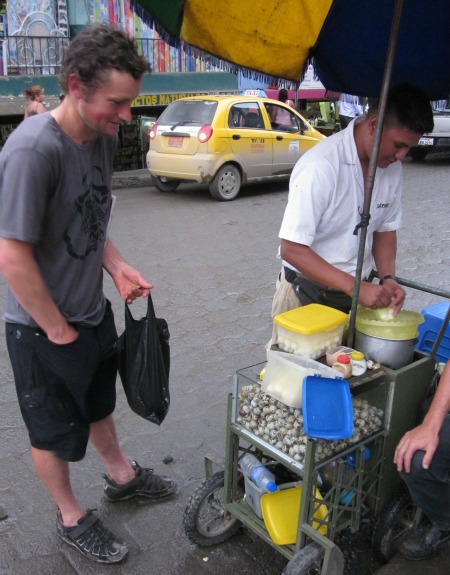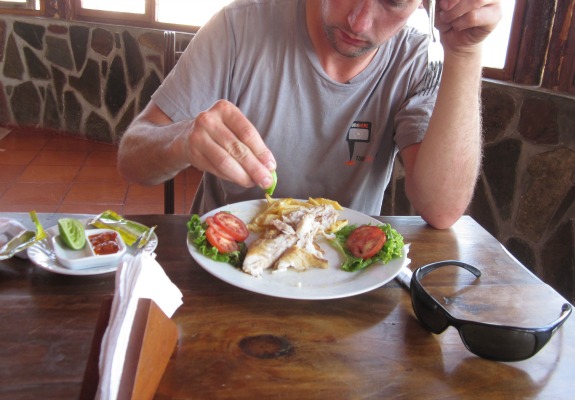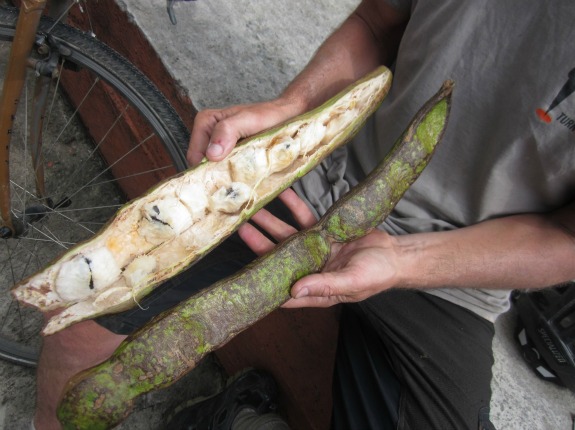What to Eat—or Not—in Peru
The ceviche carts and meat grills are colorful pieces of scenery, but eating a cherimoya or a sweet and starchy lucuma could be the truest taste of Peru
The colorful goods of the outdoor markets of Peru provide entertainment for all senses—and good food for hungry cyclists. Photo by Alastair Bland.
Symptoms of traveler’s diarrhea usually kick in an hour after the victim gets on the bus, I told my brother Andrew. He was eagerly attacking his first cooked meal in a week—a fillet of fish and fried potatoes from a small seaside restaurant in Tortugas. “It does’t matter when you get on the bus,” I elaborated. ”It’s an hour after you get on the bus.”
But he never got sick. In spite of numerous warnings from experienced travelers and stodgy medical doctors that street food, cooked food or any items that have been exposed to tap water, dirt or insects should not be eaten in Peru, we have both retained stalwart health since we began expanding our diet after a week of eating mostly fresh fruit. We started with chicha—Andean corn beer, which comes in several colors—and enjoyed its tart, fizzy bite in the town square of Huarmey. In the northern town of Tumbes we bought a hunk of local cow cheese. It was hard and aged, and it frankly left us hankering for a piece of cheese fresher and creamier, yet the fat and protein were a welcomed change. We look forward to buying more. We eyed the street vendors selling hard-boiled quail eggs for days, and now we have incorporated them into our diet. We have begun eating, as well, fresh corn—lumpy, stocky cobs sold for a few cents by street vendors working gas-powered grills. Andrew, thinking big again in the town of Puerto Pizarro, bought a whole rotisserie chicken with a three-pound bag of cooked rice and monestra (stewed beans) for 20 soles—about $8—and devoured most of the bird in less than 30 minutes. We haven’t gotten to Peru’s famous ceviche yet, though we will.

The author awaits a baggie-to-go full of hard-boiled quail eggs, a popular street snack in Peru. Photo by Andrew Bland.
And while so much savory, hot food, heavy in oils and protein, has been a happy change for us, I have to admit I’d still rather hold out for fresh and exotic fruits. I told this to a French woman we recently met on a beach near Tumbes. She flatly said I was not experiencing Peru. “Like heck I’m not! I’m riding a bike through Peru and eating locally grown specialties,” I said. “How Peruvian is that? I was in France last year cycling. I never ate foie gras or escargots but I shopped at markets and made my own meals and got a great taste of the country.” I just don’t believe that one must have a restaurant staff tiptoe around you every day at feeding time to truly experience place and culture.
Rather, I find the outdoor markets of Peru to be endlessly entertaining galas of color, smells and flavors. Foreigners can expect to find new and unusual items at almost each visit—some variety of passion fruit, avocados the size of footballs, sapotes, mameys, guaba fruits like giant bean pods or sugar cane juice. Notably, Andrew has overdosed on cherimoyas and now grows nauseous every time I start talking about them. He even observed quite astutely during his final cherimoya meal—won’t touch them now—that the fruits smell sweetly like our chain grease. Yum.

The author’s brother sets into a long-awaited savory meal—a simple fillet of fish browned in oil, served with fries and eaten in an empty beach restaurant. Photo by Alastair Bland.
But if cherimoyas turn a man’s stomach, the markets themselves are still a joy to browse. Aside from the food we take away, I also enjoy interacting with the vendors—asking names of fruits, exaggerating my surprise at the size of an avocado, asking for prices and holding out for the next stall, where the lucumas just might be ripe (most are sold three days before ripeness). Perhaps especially, I relish the power of leaving no long-awaited meal to chance—because a burning appetite for calories is nothing to waste at the end of each day. I ride my bicycle with potent visions of tropical fruit heaps luring me forward, and though a few hard-boiled eggs might tide me over until the marketplace, I will let no street vendor on the edge of town spoil my glorious meal of victory. The roving ceviche carts and meat grills are colorful pieces of street scenery, and we are enjoying some hot, savory food each day—as several readers advised we do—but eating a creamy cherimoya, a sweet and starchy lucuma or a pineapple with flesh as white and sweet as sugar could be the truest taste of Peru.

These avocados in the Tumbes market were the biggest we had yet seen—almost the size of footballs and several pounds each. Photo by Alastair Bland.
The wine
I’m usually forgiving of harsh wine while traveling. After all, just about anything from a bottle that gives a bite is appreciated late at night in a tent. But we are losing our patience with Peruvian wine. We had a bottle our first night at the Sol de Santa Rosa campground, on the bumpy road to Canta. It was a Miranda Cahuayo Semi Dry. I set aside my cherimoya to pop the cork—and the smell attacked me instantly. We had already been warned that Peruvian wine was bad, but we had disregarded the advice as the nonsense of a wine snob. But the wine was truly intolerable, smelling and tasting like rancid grease and spoiled raspberries slurried into a bucket of muddy charcoal dust. We tried again the next night with a Peruvian red whose name I neglected to record. Another disappointment—a wine so sweet and pungent that we couldn’t drink it. We vowed then to buy only wines from Chile, Argentina or other reputable producers. But the next night we got duped by a bottle with “Santiago” printed prominently on the label. A closer look during dinner revealed it was a Peruvian wine made of Concord grapes. We crossed our fingers and pulled the cork. It was a sweet, oily-tasting juice, like antifreeze. I’ve made wine in a plastic jug strapped to the back of my bike that was better. Grumbling, we poured it down the drain. A valid critic gives his subject many chances before making a conclusive statement—but how many chances must we give Peruvian wine? If someone could direct me straight to the good stuff—heck, just drinkable would be a start—I’d be grateful and would try again. But for now, we are afraid to buy another bottle.
What else can one drink in Peru? Cheap lagers are available at most grocery stores, but the main national brands taste like the cheap beer from anywhere else. There is also pisco, if you like distilled spirits. Pisco is Peru’s rendition of brandy and is often marketed by grape variety and frequently carries a nice scent of the starting grape itself—surprising for a liquid that has traveled through the tubes and chambers of a commercial still. But in a hot desert after a long day of cycling, sometimes the best drink is water.
Update
We have both gotten sick. We should have known. Book-smart medical doctors and experienced travelers warned us that eating street food or nearly anything out of a kitchen here was liable to make us run for the bathroom. Shows what they know—the bus had no bathroom. We’re going back to cherimoyas.
/https://tf-cmsv2-smithsonianmag-media.s3.amazonaws.com/accounts/headshot/Off-Road-alastair-bland-240.jpg)


/https://tf-cmsv2-smithsonianmag-media.s3.amazonaws.com/accounts/headshot/Off-Road-alastair-bland-240.jpg)